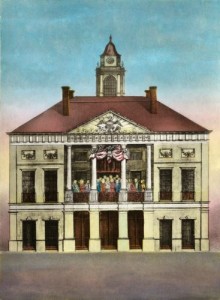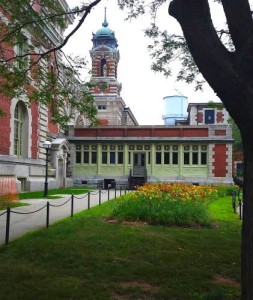The Next Green Revolution, by Tim Folger, photographs by Craig Cutler
This installation of the “Future of Food” series focuses on technological improvements in food production, including genetic modification. Folger starts out talking about the original green revolution. Fears that millions of people in Asia would die of famine led to selective breeding of wheat and rice. This allowed the volume of food to increase faster than the population, which meant that not only did they prevent the famine, but that the nutrition level of most of the people of Asia actually increased.
Now, we may be facing another potential famine and we, in Folger’s words, “need another green revolution.” And one of the potential tools for this new green revolution is genetic modification. Rather than using crossbreeding and taking your chances of developing another lenape potato (which had dangerously high levels of the poison solanin), scientists can identify the genes that contain the desirable traits and transfer them directly. These transfers can be done across species, as well. One famous example of this cross-species transfer is golden rice, which has a gene isolated from corn. This gene allows the rice to produce beta carotene. Beta carotene is the ingredient that the human body uses to produce Vitamin A. Getting enough beta carotene will not only save vision, it will save lives. Somewhere in the neighborhood of one to two million people die from Vitamin A deficiency every year.
The Next Green Revolution discusses genetic modification and the ways it could conceivably help the people of Africa and Asia in particular. Among others, we see cassava that are being bred to be resistant to brown streak virus and rice that is being bred to be able to survive under water (for use in places that are prone to flooding).
As you have likely guessed by my lack of panic, I am not against genetic modification, particularly where plants are concerned. I am not a trained scientist or anything of that nature, but I speak a little of the language of science. I am trained as a medical librarian and I work as a pharmacy technician. I can see value in genetic modification. Humans have been messing with our food forever. Just look at teosinte, the ancestor of corn. Over years and years, humans increased the size, sweetness, and nutition of the teosinte kernels until they became something entirely different. And a number of our food has been similarly changed. Watermelons are far different from their original ancestors, as well.
Most of these were done through selective breeding, which involves a lot of wasted time and resources. Let’s say that you are breeding for trait A. Your parent plants are likely to be Aa, where “a” is an undesirable trait. Half of your child plants, on average, will also be Aa. One-quarter will be aa, which won’t help at all, since “a” is exactly what you don’t want. Only one-quarter of the child plants will have the desired genes of AA. With genetic modification, you can take the A from another cell, replace the a in the original seed with it, and the plant that results will be AA. This means that plants with the desired trait can be tested for safety and put into use a lot faster than they would be with selective breeding.
When the Snows Fail, by Michelle Nijhuis, photographs by Peter Essick
In When the Snows Fail, Nijhuis discusses the drought in the southwest United States. We meet the Diener family who run a small family farm. In addition to the usual crops, almonds, broccoli, tomatoes, and so forth, the Dieners are experimenting with growing prickly pear cactus. Not only is the fruit of the prickly pear cactus edible, but so are the pads, which are known as nopales in Spanish.
The Dieners live in the Central Valley of California, which is where most of the fruits and nuts sold for food in the United States is grown. The Central Valley was chosen as a place to grow such high-water-use crops because of the richness of its soil and the moderateness of its temperatures. There is only one problem. The Central Valley has a dry climate. This means that in order to grow all of the asparagus, carrots, grapes, and pistachios, water must be pumped in. Some is groundwater pumped up from wells, but the rest must be brought in from reservoirs. These reservoirs are filled by melting snows from the mountains the surround the valley.
Thanks to climate change, the winters are becoming milder, which means less water in the mountains. Less water in the mountains then, of course, translates to less water for the farmers. This is requiring the farmers to rethink their water use and, in some cases, like Diener, the crops they grow, as well.
Medieval Mountain Hideaway, by Brook Larmer, photographs by Aaron Huey
Medieval Mountain Hideaway is about an area of the nation of Georgia known as Svaneti. For a long time, the region of Upper Svaneti was isolated from the outside by the mountains that surround it. However, from the invasion of the Russians in the 19th Century and into the 20th and 21st Centuries, much of the culture of Svaneti is slowly being lost. Only the very oldest of the Svans, for example, speak Svan fluently. The youth of Svaneti are engaged in something of a cultural revival, however, learning the old Svans songs and dances and learning to play the old Svan musical instruments. However, it is likely the much of the language which is not preserved in these songs will be lost.
Prior to the Christianization of Svaneti in the 4th century, the Svans were sun worshipers and some of those traditions, largely dealing with fire, were imported into the Christian holiday observances of the Svan.
Svaneti is facing two new threats to its culture. The first is emigration. Jobs are scares in Svaneti, and there were dangers in the area including bandits on the roads (the bandits were vanquished by security forces in 2004). Thousands of people have left for the lowlands. The village of Adishi once had 60 families, but the population dwindled to the point where only four families remained.
On top of this, the goverment is attempting to turn Svaneti into a tourist destination. The capital of Mesti, in particular, has many guest houses, and there are new ski resorts being built in the mountains around the area. The question that remains to be answered is whether tourism will save or destroy Svan culture.
Mister Big, by Tom Mueller, photographs by Mike Hettwer
Mister Big is the tale of the discovery of Spinosaurus, the largest theropod dinosaur yet discovered. The earliest bones of Spinosaurus were found in Egypt in the early 20th century by Ernst Freiherr Stromer von Reichenbach, a German paleontologist and aristocrat. Among the bones of the partial skeleton that Strohmer found were vertebrae with tall spines sticking up from them, presumably supporting a sail of some sort. Stromer gave this new discovery the name Spinosaurus aegypticus.
Stromer found it odd that so many top-level predators were found in the same area as Spinosaurus, but comparatively few herbivorous dinosaurs were found in that area. The paleontologist who figured the answer to this question was Nizar Ibrahim.
In 2008, Ibrahim was shown some dinosaur bones, one of which was broken, in purplish sandstone. He bought the bones, despite their condition. In 2009, he saw a partial Spinosaurus in a museum in Milan, and it was clear that the bone he had bought was broken off of one of the bones of the dinosaur in Milan.
In 2013, he found the fossil hunter who sold him that first piece of Spinosaurus (and who also sold the bones in the Milan museum). Ibrahim has since found more bones that are likely from that individual and perhaps bones from others as well, in that location.
The current belief is that Spinosaurus spent at least part of its time in the water. This would explain some peculiarities in the anatomy of the Spinosaurus, including the positioning of its back legs, which would be better for paddling than for walking. Also, this would explain the relative lack of prey — the valley where the Spinosaurus was found was part of a network of rivers that was inhabited by large aquatic animals, including both fish and turtles.
The Nuclear Tourist, by George Johnson, photographs by Gerd Ludwig
Chernobyl, in Ukraine (it is a real challenge for me to get used to not typing the “the” that used to be in front of “Ukraine”), is the site of the worst nuclear disaster in history. For some unknown reason, on April 26, 1986 the people operating the reactor at Chernobyl decided to do a safety test with a skeleton staff. As it turned out, the plant was not safe. During the test, the reactor overheated and there were two explosions. Most upsetting of all, it took 36 hours for them to start to evacuate the nearby residents. In June of 1986, work began on enclosing the building in a steel and concrete enclosure known in English as the “sarcophagus.” The sarcophagus was completed in November 1986. However, the sarcophagus was not sealed properly, and so beginning in 2006, construction on another enclosure, called the New Safe Confinement, was begun. In 2011, Chernobyl was opened for business as a tourist attraction.
The Nuclear Tourist is an account of the one tour group’s trip into the Chernobyl area. We see, in words and pictures, the damage done by the disaster, by time, and by tourist groups and the occasional vandal. I found particularly interesting how relaxed the tourists became about radiation. At one point, the tour guide actually led the group into a high-radiation area and the tourists used their radiation meters to see how high it would go.
Speaking of radiation, the one thing that I found confusing about The Nuclear Tourist were Johnson’s references to radiation levels. I spent a bit of time checking his math and referring back to other parts of the article. He also opens with the statistic that five sieverts of radiation will kill you, then says that the rescue workers were exposed to 16 sieverts. My initial response was, “Wouldn’t that have killed them?” I’m still working on that one. From what I’ve seen in other sources, it looks like they did develop acute radiation sickness but didn’t die until several days later.
(originally posted June 2015)



